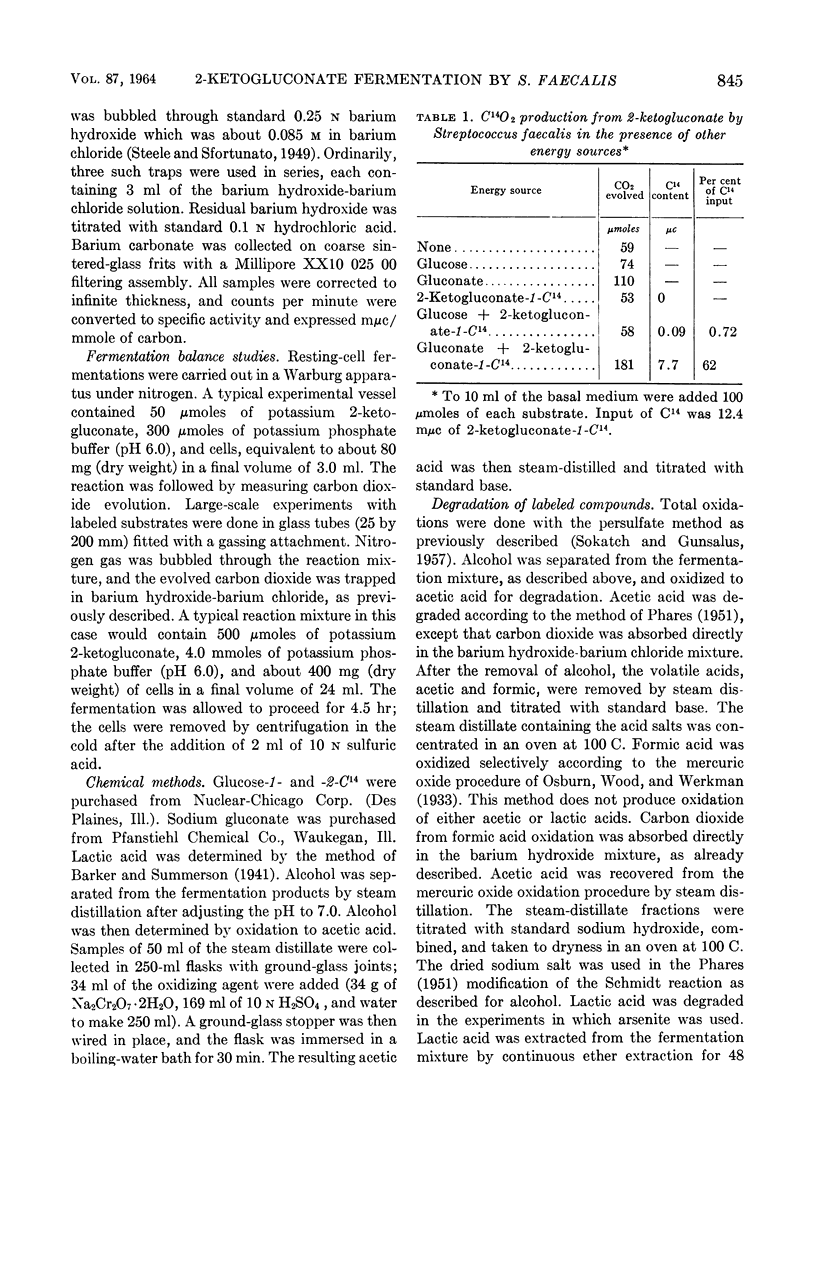Abstract
Goddard, J. L. (University of Oklahoma School of Medicine, Oklahoma City), and J. R. Sokatch. 2-Ketogluconate fermentation by Streptococcus faecalis. J. Bacteriol. 87:844–851. 1964.—Streptococcus faecalis 10Cl did not grow with 2-ketogluconate alone as an energy source, but did grow when gluconate was added. More growth was obtained than could be accounted for by the gluconate alone. The requirement for gluconate in the stimulation of growth on 2-ketogluconate was found to be stoichiometric, not catalytic. Glucose did not replace gluconate in this phenomenon, apparently owing to the repression of the 2-ketogluconate pathway by glucose. Resting cells grown on a combination of gluconate and 2-ketogluconate did ferment 2-ketogluconate without added gluconate. Fermentation balance studies with resting cells detected the following products in moles (per mole of 2-ketogluconate): carbon dioxide, 0.98; lactic acid, 0.19; formic acid, 1.42; acetic acid, 0.70; and ethanol, 0.42. 2-Ketogluconate-1-C14 and -2-C14 were prepared and fermented. The data were interpreted to show that 90% of the substrate was decarboxylated to carbon dioxide and pentose phosphate. Pentose phosphate was then fermented to pyruvate through the sedoheptulose diphosphate variation of the pentose phosphate pathway found in this organism. The other 10% of the substrate was converted to pyruvate by way of the Entner-Doudoroff pathway. Calculations of the energy available by the above combination of pathways indicated that about 2.3 moles of adenosine triphosphate per mole of 2-ketogluconate could be obtained if the energy available in acetate formation is conserved through the acetokinase reaction.
Full text
PDF







Selected References
These references are in PubMed. This may not be the complete list of references from this article.
- BAUCHOP T., ELSDEN S. R. The growth of micro-organisms in relation to their energy supply. J Gen Microbiol. 1960 Dec;23:457–469. doi: 10.1099/00221287-23-3-457. [DOI] [PubMed] [Google Scholar]
- BLAKLEY E. R., BLACKWOOD A. C. The degradation of 2-keto-D-gluconate-C14, D-gluconate-C14, and D-fructose-C14 by Leuconostoc mesenteroides. Can J Microbiol. 1957 Aug;3(5):741–744. doi: 10.1139/m57-083. [DOI] [PubMed] [Google Scholar]
- DE LEY J. 2-Keto-D-gluconate-6-phosphate, a new intermediate in the carbohydrate metabolism of Aerobacter cloacae. Enzymologia. 1954 Jul 15;17(1):55–68. [PubMed] [Google Scholar]
- ELSDEN S. R., PEEL J. L. Metabolism of carbohydrates and related compounds. Annu Rev Microbiol. 1958;12:145–202. doi: 10.1146/annurev.mi.12.100158.001045. [DOI] [PubMed] [Google Scholar]
- ENTNER N., DOUDOROFF M. Glucose and gluconic acid oxidation of Pseudomonas saccharophila. J Biol Chem. 1952 May;196(2):853–862. [PubMed] [Google Scholar]
- FRAMPTON E. W., WOOD W. A. Carbohydrate oxidation by Pseudomonas fluorescens VI. Conversion of 2-keto-6-phosphogluconate to pyruvate. J Biol Chem. 1961 Oct;236:2571–2577. [PubMed] [Google Scholar]
- FUKUYAMA T. T., O'KANE D. J. Galactose metabolism. I. Pathway of carbon in fermentation by Streptococcus faecalis. J Bacteriol. 1962 Oct;84:793–796. doi: 10.1128/jb.84.4.793-796.1962. [DOI] [PMC free article] [PubMed] [Google Scholar]
- JUNI E., HEYM G. A. Determination of carbonyl acids formed upon periodate oxidation. I. Assay procedure. Anal Biochem. 1962 Aug;4:143–158. doi: 10.1016/0003-2697(62)90031-3. [DOI] [PubMed] [Google Scholar]
- NORTON J. E., BULMER G. S., SOKATCH J. R. THE OXIDATION OF D-ALANINE BY CELL MEMBRANES OF PSEUDOMONAS AERUGINOSA. Biochim Biophys Acta. 1963 Oct 8;78:136–147. doi: 10.1016/0006-3002(63)91619-6. [DOI] [PubMed] [Google Scholar]
- O'kane D. J., Gunsalus I. C. Pyruvic Acid Metabolism: A Factor Required for Oxidation by Streptococcus faecalis. J Bacteriol. 1948 Oct;56(4):499–506. doi: 10.1128/jb.56.4.499-506.1948. [DOI] [PMC free article] [PubMed] [Google Scholar]
- PHARES E. F. Degradation of labeled propionic and acetic acids. Arch Biochem Biophys. 1951 Sep;33(2):173–178. doi: 10.1016/0003-9861(51)90094-x. [DOI] [PubMed] [Google Scholar]
- SOKATCH J. R. Phosphorylation of sedoheptulose 7-phosphate by Streptococcus faecalis. Arch Biochem Biophys. 1962 Dec;99:401–408. doi: 10.1016/0003-9861(62)90286-2. [DOI] [PubMed] [Google Scholar]
- SOKATCH J. T., GUNSALUS I. C. Aldonic acid metabolism. I. Pathway of carbon in an inducible gluconate fermentation by Streptococcus faecalis. J Bacteriol. 1957 Apr;73(4):452–460. doi: 10.1128/jb.73.4.452-460.1957. [DOI] [PMC free article] [PubMed] [Google Scholar]
- STEELE R. H., WHITE A. G., PIERCE W. A., Jr The fermentation of galactose by Streptococcus pyogenes. J Bacteriol. 1954 Jan;67(1):86–89. doi: 10.1128/jb.67.1.86-89.1954. [DOI] [PMC free article] [PubMed] [Google Scholar]
- STOKES F. N., CAMPBELL J. J. R. The oxidation of glucose and gluconic acid by dried cells of Pseudomonas aeruginosa. Arch Biochem. 1951 Jan;30(1):121–125. [PubMed] [Google Scholar]
- Wood A. J., Gunsalus I. C. The Production of Active Resting Cells of Streptococci. J Bacteriol. 1942 Sep;44(3):333–341. doi: 10.1128/jb.44.3.333-341.1942. [DOI] [PMC free article] [PubMed] [Google Scholar]


